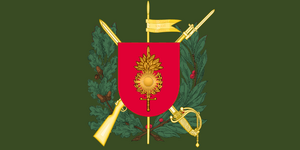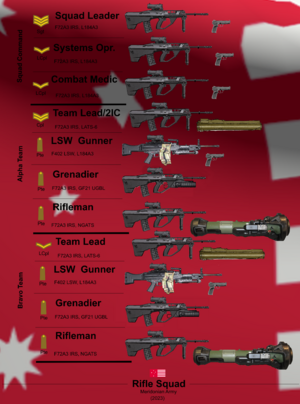Meridonian Army: Difference between revisions
No edit summary |
|||
| (10 intermediate revisions by the same user not shown) | |||
| Line 31: | Line 31: | ||
|website = | |website = | ||
<!-- Commanders --> | <!-- Commanders --> | ||
|commander1 = [[ | |commander1 = [[Yui Townley]] | ||
|commander1_label = [[President of Meridon|Commander-in-Chief]] | |commander1_label = [[President of Meridon|Commander-in-Chief]] | ||
|commander2 = [[Jason Merritt]] | |commander2 = [[Jason Merritt]] | ||
| Line 37: | Line 37: | ||
|commander3 = Alan Pierro | |commander3 = Alan Pierro | ||
|commander3_label = Army Secretary | |commander3_label = Army Secretary | ||
|commander4 = | |commander4 = ADM Benjamin Collins | ||
|commander4_label = Chief of Defense Staff | |commander4_label = Chief of Defense Staff | ||
|commander5 = Gen [[Arthur McCann]] | |commander5 = Gen [[Arthur McCann]] | ||
| Line 59: | Line 59: | ||
The Meridonian Army, taking its roots from European and specifically English influences, was in its modern founded in 1739 by the Union Council in order to fight the [[Second Meridonian Civil War]] against the Sovereignist coalition, however it traces its origins back to the militia units of the original European citystates. The Army, along with the [[Meridonian Navy]], existed as independent forces without a real unified command structure until 1833, where it was subordinated under the War Office alongside the Navy. A need for greater joint forces command, realized during the Second World War, resulted in the restructuring of the armed forces and the establishment of the [[Meridonian Defense Forces]] and the [[Defense Department (Meridon)|Defense Department]]. | The Meridonian Army, taking its roots from European and specifically English influences, was in its modern founded in 1739 by the Union Council in order to fight the [[Second Meridonian Civil War]] against the Sovereignist coalition, however it traces its origins back to the militia units of the original European citystates. The Army, along with the [[Meridonian Navy]], existed as independent forces without a real unified command structure until 1833, where it was subordinated under the War Office alongside the Navy. A need for greater joint forces command, realized during the Second World War, resulted in the restructuring of the armed forces and the establishment of the [[Meridonian Defense Forces]] and the [[Defense Department (Meridon)|Defense Department]]. | ||
The Army in its modern day form is a fully professional fighting force. It, alongside the rest of the Armed Forces (excluding the Air Forces and their predecessor, the Army Air Forces) conducted mandatory conscription from | The Army in its modern day form is a fully professional fighting force. It, alongside the rest of the Armed Forces (excluding the Air Forces and their predecessor, the Army Air Forces) conducted mandatory conscription from 1938 to 1960, but has since been able to maintain sufficient numbers through volunteers alone. The Army is designed around high mobility and expeditionary warfare, and has a good mix of unit capabilities to meet this goal. It is administered by the [[Department of the Army]] as a civilian oversight agency. It is commanded, however, by the [[Chief of Army Staff (Meridon)|Chief of Army Staff]],a 4 star officer and the seniormost commissioned officer in the Army. It regularly conducts operations and exercises along other nations, including peacekeeping and training exercises. | ||
==History== | ==History== | ||
===Early Iterations=== | ===Early Iterations=== | ||
| Line 80: | Line 80: | ||
===Structure=== | ===Structure=== | ||
''Main article: [[Structure of the Meridonian Army]]'' | |||
[[File:MA_Rifle_Squad.png|thumb|Organization of a Meridonian army rifle squad, circa 2023.]] | |||
===Special operations forces=== | ===Special operations forces=== | ||
| Line 159: | Line 96: | ||
<gallery> | <gallery> | ||
Soldiers from the 176th Air Dispatch Squadron talk while waiting for inbound aircraft at Londonderry Drop Zone in March 2017.jpg|Army soldiers from | Soldiers from the 2nd Royal Australian Regiment execute a security halt on a beach during an amphibious assault exercise in 2015.jpg| Soldiers from 52 Regiment Howam Light conducting exercises in Redbird Territory. | ||
Soldiers from the 176th Air Dispatch Squadron talk while waiting for inbound aircraft at Londonderry Drop Zone in March 2017.jpg|Army soldiers from 12 Battalion Military Police wearing MDCU patterned GPWU fatigues. | |||
Australian soldiers marching through Darwin on Anzac Day 2018.jpg|Officers and other ranks of the 26 RGMI marching during a parade in Cordelia wearing Class II summer dress uniforms. | Australian soldiers marching through Darwin on Anzac Day 2018.jpg|Officers and other ranks of the 26 RGMI marching during a parade in Cordelia wearing Class II summer dress uniforms. | ||
Australian Army band at the No 28 Squadron RAAF freedom of the city parade August 2013.jpg| Regimental Band, 1 Regiment Federal marching in Class II dress uniforms. | Australian Army band at the No 28 Squadron RAAF freedom of the city parade August 2013.jpg| Regimental Band, 1 Regiment Federal marching in Class II dress uniforms. | ||
| Line 187: | Line 125: | ||
| style="text-align:center;"| Various | | style="text-align:center;"| Various | ||
|- style="text-align:center;" | |- style="text-align:center;" | ||
|Rank title||''Field Marshal''||''General''||''Lieutenant General''||''Major General''||'' | |Rank title||''Field Marshal''||''General''||''Lieutenant General''||''Major General''||''Regimental General ''||''Colonel''||''Lieutenant Colonel''||''Major''||''Captain''||''Lieutenant''||''Second Lieutenant''||Various | ||
|- style="text-align:center;" | |- style="text-align:center;" | ||
|Abbrevation||FM||Gen||LGen||MGen|| | |Abbrevation||FM||Gen||LGen||MGen||RGen||Col||LCol||Maj||Cpt||Ltn||2Lt||Various | ||
|} | |} | ||
Latest revision as of 14:08, 7 April 2024
| Meridonian Army | |
|---|---|
 Service flag of the Meridonian Army | |
| Active | 06 May 1739 - present |
| Country | |
| Type | Army |
| Role | Land warfare |
| Size | 106,482 |
| Part of | |
| Ceremonial Garrison | Greycreek Barracks, Alexandria |
| Motto(s) | Through Valor, Liberty |
| Colors | Ranger Green, Army Gold |
| March | Over the Hills and Far Away |
| Engagements | Second Meridonian Civil War |
| Commanders | |
| Commander-in-Chief | Yui Townley |
| Defense Secretary | Jason Merritt |
| Army Secretary | Alan Pierro |
| Chief of Defense Staff | ADM Benjamin Collins |
| Chief of Army Staff | Gen Arthur McCann |
| Vice Chief of Army Staff | LGen Kenneth Bradston |
| Army Sergeant Major | Vincent Campbell |
| Insignia | |
| Service badge |  |
| Aircraft roundel |  |
| Alternate low-vis roundel |  |
The Meridonian Army is the land warfare component of the Meridon Defense Forces. It is composed of 106,482 active duty troops, and about 50,000 reservists as of 2022. It is the largest service branch in the Meridon Defense Forces.
The Meridonian Army, taking its roots from European and specifically English influences, was in its modern founded in 1739 by the Union Council in order to fight the Second Meridonian Civil War against the Sovereignist coalition, however it traces its origins back to the militia units of the original European citystates. The Army, along with the Meridonian Navy, existed as independent forces without a real unified command structure until 1833, where it was subordinated under the War Office alongside the Navy. A need for greater joint forces command, realized during the Second World War, resulted in the restructuring of the armed forces and the establishment of the Meridonian Defense Forces and the Defense Department.
The Army in its modern day form is a fully professional fighting force. It, alongside the rest of the Armed Forces (excluding the Air Forces and their predecessor, the Army Air Forces) conducted mandatory conscription from 1938 to 1960, but has since been able to maintain sufficient numbers through volunteers alone. The Army is designed around high mobility and expeditionary warfare, and has a good mix of unit capabilities to meet this goal. It is administered by the Department of the Army as a civilian oversight agency. It is commanded, however, by the Chief of Army Staff,a 4 star officer and the seniormost commissioned officer in the Army. It regularly conducts operations and exercises along other nations, including peacekeeping and training exercises.
History
Early Iterations
Formation
1800's
Early 1900's
Post-war
Modern day
Organization
The Army consists of two components- Regular and Reserve. Regular formations compose the active-duty formations of the Army and comprise the majority of its strength, including all of its deployable brigades. Reserve formations consist of both part time soldiers and lower readiness formations that are generally relegated to defense support activities on an as-needed basis. Reserve soldiers, at a minimum, conduct training two days per month with their formation and three weeks of annual training a year.
The Army is headed by the Chief of Army Staff, the highest-ranking commissioned officer in the Army, who sits on the Defense General Staff as its seniormost representative. The COAS reports to the Army Secretary, who reports to the Defense Secretary, who primarily advises the President of Meridon on all defense matters and is responsible for implementing civilian policy into the Army.
Structure
Main article: Structure of the Meridonian Army
Special operations forces
See also:Special Operations Forces Command
Special warfare forces are organized under the Army Special Forces Group (ASFG), which regularly interoperates and reports to Special Operations Forces Command (SOFCOM). ASFG consists of a number of tenant special forces unit.
Equipment
See also:Modern equipment of the Meridonian Army
Uniforms
Personnel
See also:Military ranks of the Meridon Defense Forces#Meridonian Army
Commissioned officers
| DD Pay Grade | OF11 | OF10 | OF9 | OF8 | OF7 | OF6 | OF5 | OF4 | OF3 | OF2 | OF1 | OFC |
|---|---|---|---|---|---|---|---|---|---|---|---|---|
Army |

|

|

|

|

|

|

|

|

|

|

|
Various |
| Rank title | Field Marshal | General | Lieutenant General | Major General | Regimental General | Colonel | Lieutenant Colonel | Major | Captain | Lieutenant | Second Lieutenant | Various |
| Abbrevation | FM | Gen | LGen | MGen | RGen | Col | LCol | Maj | Cpt | Ltn | 2Lt | Various |
Other ranks
| DD Pay Grade | WO1 | WO2 | WO3 | WO4 | WO5 | OR6 | OR5 | OR4 | OR3 | OR2 | OR1 | Recruit | ||||
|---|---|---|---|---|---|---|---|---|---|---|---|---|---|---|---|---|
Army |

|

|

|

|

|

|

|

|
No rank insignia | No rank insignia | ||||||
| Rank title | Warrant Officer Class 1 | Warrant Officer Class 2 | Warrant Officer Class 3 | Warrant Officer Class 4 | Warrant Officer Class 5 | Staff Sergeant | Master Sergeant | Color Sergeant | First Sergeant | Technical Sergeant | Sergeant | Corporal | Lance Corporal | Private | Recruit | |
| Abbrevation | WOC1 | WOC2 | WOC3 | WOC4 | WOC5 | SSgt | MSgt | CSgt | 1Sgt | TSgt | Sgt | Cpl | LCpl | Pte | Rct | |





